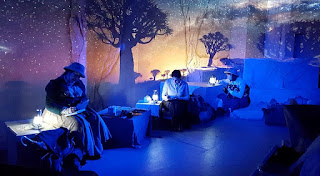Published in the Weekly Volcano, Feb. 25, 2016
 |
| "Torso" cast porcelain with gold leaf by Claudia Fitch, number one from edition of two, gift of Lucy and Herb Pruzan. |
The first thing to catch the eye when entering the gallery
of new gifts to the Tacoma Art Museum is Guy Anderson's "Mountain
Picnic," a moody painting in oil on paper mounted on plywood. Next to it
is an equally dark and moody painting by Paul Horiuchi titled "Religious
Heritage", and "Introspection," a huge, equally dark painting by
Milton Simons. Nearby can be seen Kenneth Callahan's untitled painting of
fishermen or workers in a fish market (it's not clear which). These works
provide a fitting opening to a show celebrating (mostly) Pacific Northwest art,
because Anderson, Horiuchi and Callahan were all associated with the Northwest
Mystics or the Northwest School, which put our region on the international art
map.
 |
| "Capitoline Museum: Dying Gaul" pastel on paper, 53' x 72", gift of Lynn Loacker. |
Over the past five years, TAM has increased its permanent
collection to the tune of more than a thousand works of art. A large selection
of these works is included in this show, including paintings, sculptures,
drawings and prints, jewelry and more. It is a fairly representative collection
focusing on the museum's stated mission of ensuring the collections grows
"to fully represent the rich artistic identity of the Northwest and
broader western region."
There are some wonderful works of art to be seen, such as Michael
Spafford's three-part etching, "Leda and the Swan" and Drew Daly's
Escher-like sculpture, "Spindleback Merge." There are also some
pieces that are not museum worthy, such as Howard Kottler's ceramic sculpture,
"Sheldon" and Elizabeth Sandvig's "Peaceable Kingdom with
Clouds."
Sandvig has created many excellent paintings, but this is
not one of them. It is one of many in a series of "Peaceable Kingdom"
paintings on the subject made famous by the strange and wondrous painting of
lions and cattle and cherubic children by Edward Hicks. Sandvig's painting
looks clumsy and has none of the strangeness of Hicks' famous painting nor even
of other Sandvig paintings.
Like Sandvig, Kottler has produced some outstanding art, but
"Sheldon" is just clunky and garish.
But the good stuff - oh, the good stuff is delicious.
Spafford's three etchings on the myth of Leda and the Swan are beautiful and
strong, with a plethora of patterns, shapes and marks hidden within deceptively
minimalist curvilinear forms. They are strong and sensual, and show the hand of
a master. Similarly, Lauri Chambers' untitled oil painting has a lot going on
within what appears to be nothing more than two black lines on a big white
canvas. Almost hidden on the edges of her forms are layers and layers of marks
and scrapings, and the strong black shapes divide the canvas into an
interestingly asymmetric balance of positive and negative shapes.
WHAT'S NEW AT TAM? RECENT GIFTS TO THE COLLECTION, Tuesday-Sunday, 10 a.m. to 5 p.m., through Sept. 18,
$12-$14, Tacoma Art Museum, 1701 Pacific Ave. Tacoma, www.tacomaartmuseum.org






